What Do You Need To Start Crocheting?
I learned to crochet from my mom back when I was just a little girl. I must have chained thousands of stitches over and over. It was such great practice and hooked me on this handicraft. (no pun intended)
If you are starting this journey all by yourself there are a few basic things to know that will help you out quite a bit. My mom just gave me a hook, scissors, and yarn. And that is all I ever used for years. And that is all that you really need.
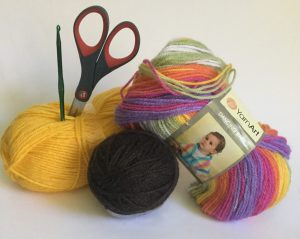
Yarn, scissors,and a crochet hook is all you need to start crocheting.
I’ve added a darning needle (I use it to weave in the ends) to the mix now, but you can get away without it.
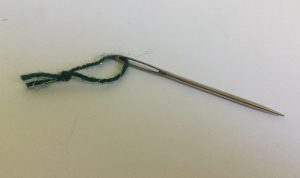
Darning needles work great to weave in those ends. I like to leave a little bit of yarn in mine when I am not using it to help me keep track of it…aka…not lose it!
Crochet Hook Sizes
Crochet hooks come in many sizes and the sizes are labeled differently in different areas of the world. There are 3 guages that I am aware of: letters, numbers, and metric. They all basically contain the same sizes, but are just labeled differently.
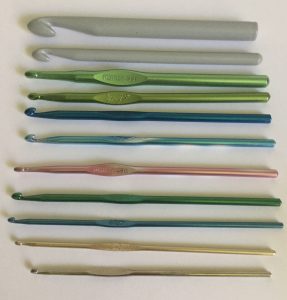
Crochet hooks come in a variety of sizes.
Here is a good guide to see the differences visually. ( crochet hook guide)
Crochet Stitches
Crochet stitches have names which can change based on which region of the world they are coming from. American and British use different terms for some of the same stitches. To read a pattern you will need to learn a few basic abbreviations.
When you see the whole list it can be overwhelming, but you won’t use most of them to start out with. So don’t let that hold you back from getting started.
Here is a good guide to see those differences. ( crochet abbreviations )
What Size of Crochet Hook Should I Use?
I think if you are starting it is easiest to just pick up a size G hook. There are tons of sizes, but really you don’t need them all to begin with. This is an easy size to start with and works well with most of the cheap yarn out there.
If you get too small of a hook, you’ll need to get thinner yarn and it’s just a tad harder to learn with. The same is true on the fatter hooks. You would need really thick yarn, which usually costs a bit more and I think is a little trickier for starting. But everyone is different.
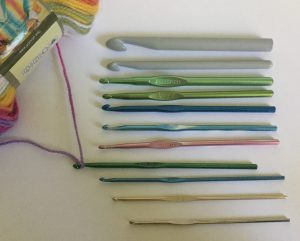
The G crochet hook is the one pulled out with the yarn to the left.
I’ve come to believe that in crocheting there aren’t a lot of wrong ways or right ways to do things per se….it’s more of what works for you. Play around with it.
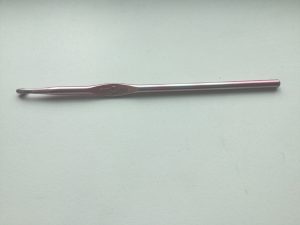
G crochet hook
What Size of Crochet Hook Should You With Your Yarn?
The easiest way to get yarn that is a good match for your crochet hook is to just look on the yarn label itself. Most yarn labels will have a little spot on the back that gives the crochet hook sizes and even knitting needle sizes that are recommended for that particular yarn. So just look for a yarn that recommends a G hook.
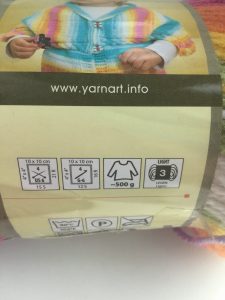
This label shows you the basic information about the yarn including what is the recommended size of crochet hook and knitting needles to use.
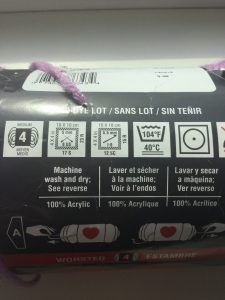
Here is another yarn label from a different brand. Again showing the same type of information.
Once you have the hook and yarn, you need scissors.. We all have a pair somewhere in the house. Whether or not you can find them, might be the better question, if your house is at all like mine. My kids are forever running off….not literally, thank goodness…..with my scissors and tape.
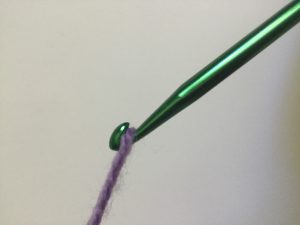
This is how the yarn should fit in the hook. Notice how it is fit snug in the crochet hook, but not super thin compared to the crochet hook either. This a G hook with yarn that calls for a G sized hook!
Crochet For Beginners
The basics of beginning to stitch include: how to hold the yarn in your left hand, how to hold your hook in your right hand, and the series of looping yarn over the hook and pulling through.
The very first thing you’ll need to learn is the slip knot. This creates the beginning loop you will crochet with. Here is a great video to walk you through learning that step.
There is an endless supply of YouTube videos on how to do this. Just pick one and practice that method. There are different ways to hold your yarn and even how to hold the hook.
This here is a great video that shows both how to hold your yarn in your right hand and also how to do a chain stitch….which is the most basic crochet stitch you need to learn first.
No matter which way you choose to learn, it will take a little bit of time to get comfortable with it. Don’t give up at first because it doesn’t feel natural. You can so learn this! Just practice making chains and then work your way upward adding on to those stitches.
Now to Crochet Your First Project
Good projects to begin once you get the hang of it are: pots holders, washcloths, or even a small baby blanket. Like any new skill, you just have to put time and effort into in and soon you will be enjoying the fruit of your labor. It’s pretty awesome to look at a completed blanket and know you that you created it all by hand….all by yourself.
If you are more of a visual learner, here is a another great video to watch.
Crocheting is a great craft/skill to learn. I’ve spent countless hours making things for others over the years and it has always brought me great joy. It’s been fun to pass on to my daughters. It’s a timeless craft and the possibilities of what you can do with it are only limited by your own imagination.
Important Crochet Tip….Learn From My Mistakes!
One final tip that I learned about the hard way….. when you finish up with your yarn or end of your project…DO NOT just tie a knot and cut the end. My experience is that those type of ends do not last long term.
Nothing is more frustrating than working on a large project only for it come unraveled….this happened to me with my oldest daughter’s baby blanket. Now that blanket might have taken more abuse than some things…..
With my new method, my “baby’s” baby blanket has no spots coming unraveled.….and that is 5 years of being dragged around and loved on. The true test of how well anything will stay nice has to be a toddler and pre-school child.
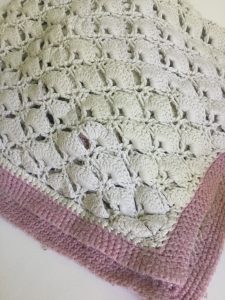
My youngest daughter’s crocheted blanket. Well loved. I used a cotton blend yarn to improve the odds that it would hold up to a growing baby.
I have found that by weaving in the ends with a darning hook, I’ve had remarkable success at keeping things from coming unraveled
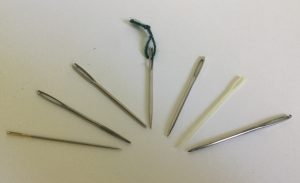
Darning needles come in a variety of sizes also. Somehow, I have a whole collection of them, but any one of them is perfect. I just use the first one I can reach out of my jar of crochet hooks and darning needles. Nothing scientific to my method!
I usually leave a 6-10 inch tail that I weave in. Maybe that’s a bit excessive, but I don’t like going to so much work and it coming out. My only exception is if it’s a tiny little flower or something small that won’t be taking hours of abuse from a kid.
Happy Crocheting!